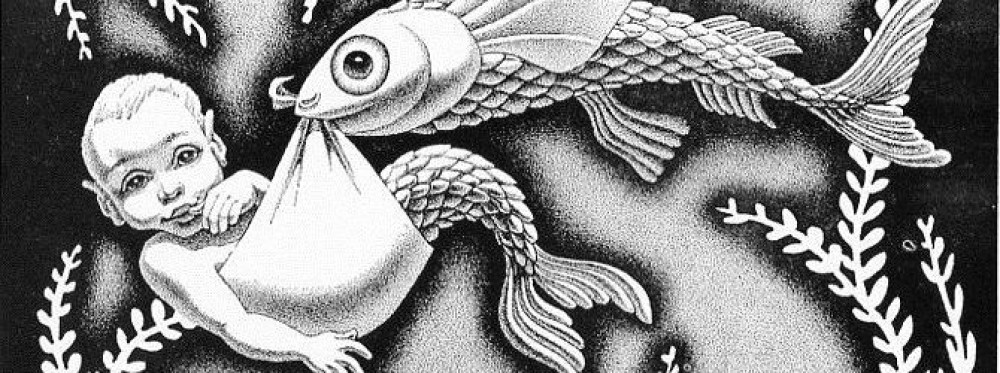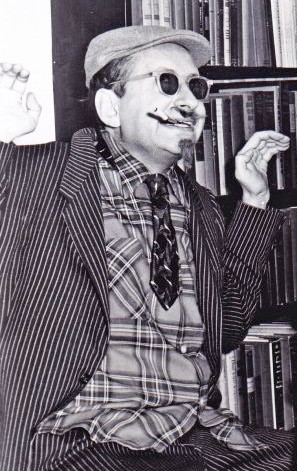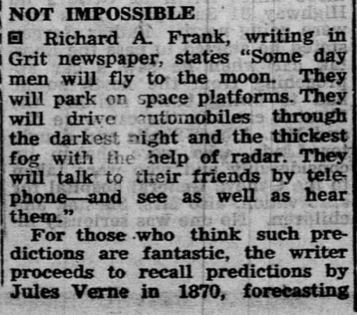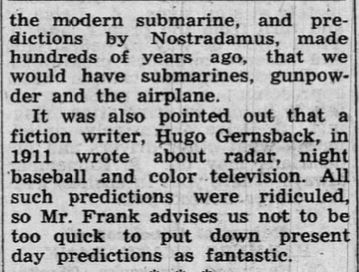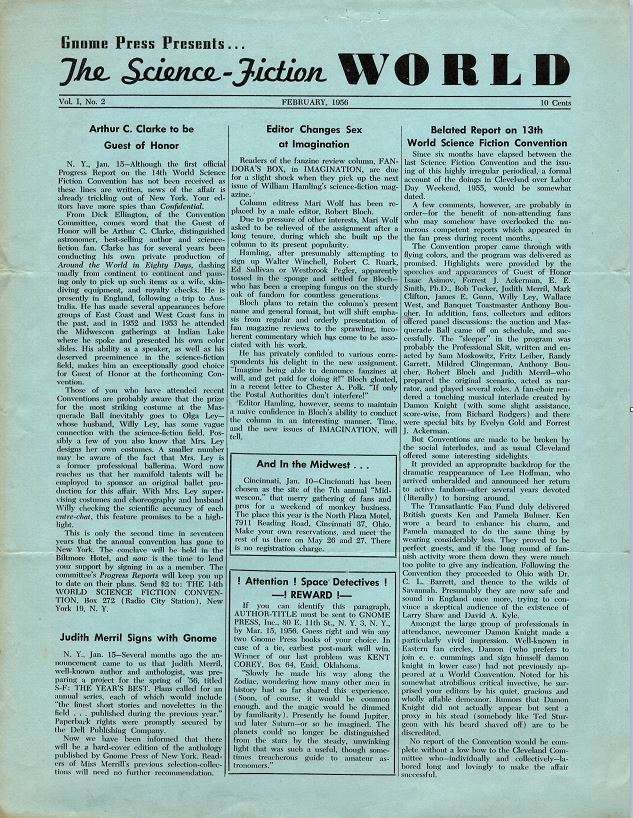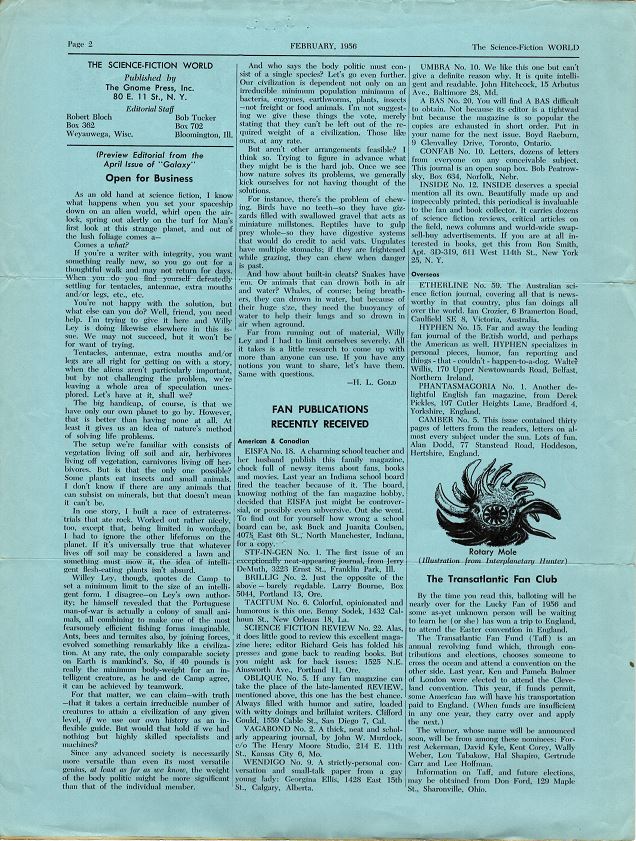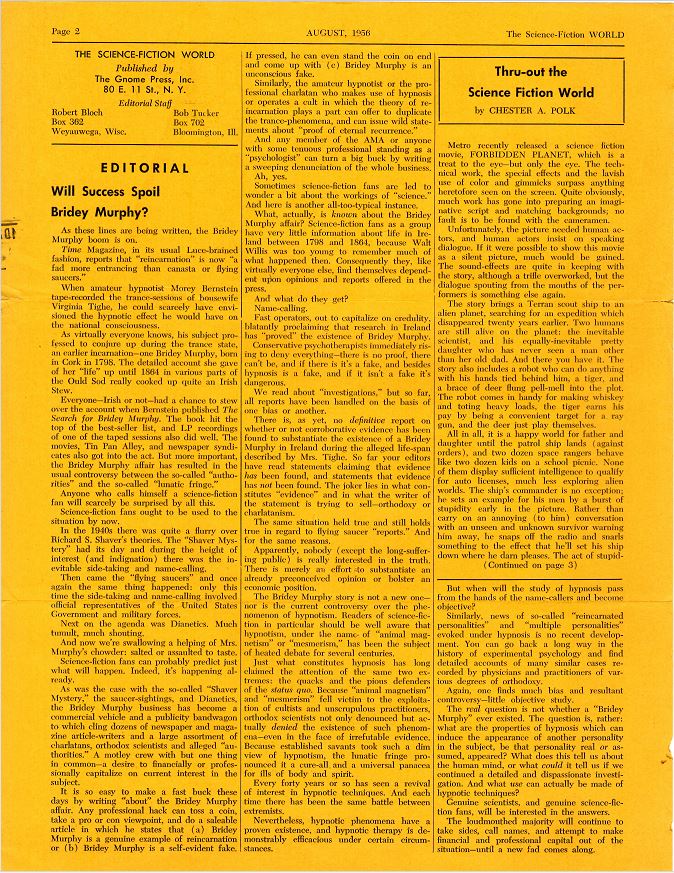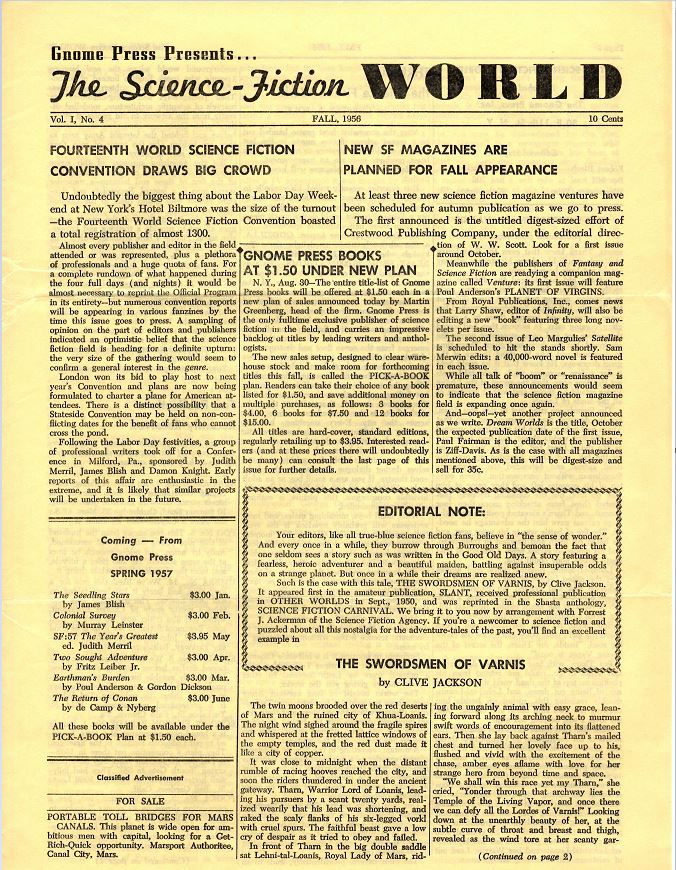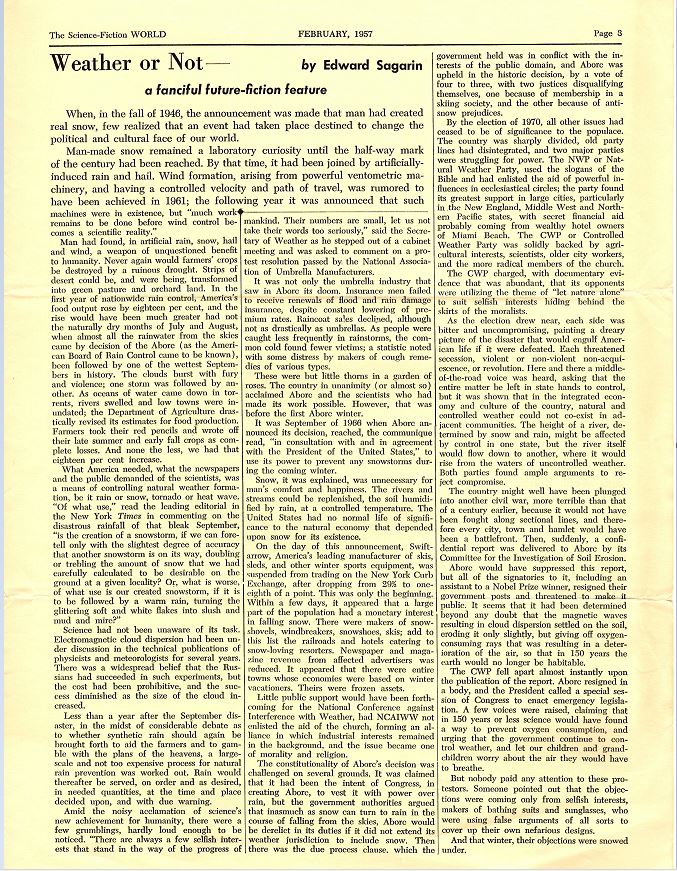Just because Greenberg didn’t publish catalogs in the mid-1950s didn’t mean his mind wasn’t busy spinning off ideas. August 1955 saw the introduction of perhaps the most desirable piece of Gnome ephemera, “four issues of a newsletter edited by Wilson ‘Bob’ Tucker and Robert Bloch, The Science-Fiction World, which included promos for Gnome books, interviews, art, etc.,” wrote CHALKER, adding that “these are so rare that we have never, and we mean never, seen a copy of any of them for sale.” I am always awed that people managed to do the prodigious amounts of research they left us from the pre-Internet days, and this merely emphasizes how difficult research must have been when each item had to be physically handled and traced.
There were, in fact, six issues of The Science-Fiction World: No. 1, August 1955; No. 2, February 1956; No. 3, August 1956; No, 4, Fall 1956; No. 4 [sic], February 1957; No. 5 [sic], Spring 1957. Yes, they printed two issues labeled Vol. 1, No. 4. Gnome to the bone. The newsletter was intended to be a quarterly but appeared quite irregularly, making it instantly dated as a newsletter. (A previous fanzine called Science Fiction World, with and without a hyphen, appeared in 1945 and 1946.)
The six issues were each published on a different color of 12” x 18” paper, folded once, except for issue No. 2, which was 12.5” x 19”. That made for a 4-page product. The issues were then tri-folded, with the bottom third of the last page left blank to add a mailing address. Those addresses were typed by different hands on different machines, leaving open the question of who did the scut work. The return address was Gnome’s office.
As usual, Marty Greenberg had wildly unrealistic goals for his latest great idea. A squib in the December 1957 issue of Imagination claimed that “This assemblage of fresh news and stale jokes goes to a distribution and mailing group of approximately 30,000 people — several of whom actually seem to read it.” I wonder what response people got when they wrote to Gnome asking for one and including their dime to pay for the publication, considering that the newsletter had already been dead for six months.
Greenberg picked his editors well. Arthur Wilson “Bob” Tucker (1914-2006) had been a fan since his teens, and quickly became one of the more prolific and central fan writers in the country. He vacuumed in info about the fan and pro worlds from his home in Bloomington, IL, (Bloch’s memory put him in Wilmington, but I can find nothing to back that up) making his several fanzines must readings. His presence at a convention was a walking party and celebration. Throughout the 1940s Tucker wrote a number of book-length mysteries, simply because there was no outlet for original science-fiction novels. When that dam broke he put out five books from 1951 through 1955, and continued more slowly until 1981. Known for one of the best senses of humor in the field, he was a perfect choice to write a light-hearted quasi-fanzine to lure readers.
Robert Albert Bloch, usually known as “Bob” (1917-1994), was a fan by the early 1930s as were so many of the crew in the 1950s. He put out some fanzines of his own, but mostly wrote for others, because he was so busy writing professionally. He sold his first pro story to Weird Tales at the age of seventeen. Hundreds more would follow for the next six decades. Bloch was mostly a fantasy and horror writer; his first collection was published by Arkham House. Most famously, he wrote Psycho, the book. It was published as an Inner Sanctum Mystery. Horror was not an individual publishing genre in the 1950s. His humor was similarly renowned in the field. As a side note, Bloch wrote about the fan world in a column for Imagination: he was the tongue-in-cheek author of the squib above. How he possibly could have not known that The Science Fiction WORLD had come to an end is another Gnome mystery. That same “Fandora’s Box” column contained a long description of his attendance at the June 1957 MidWestCon, and his cavorting with both Marty Greenberg and Bob Tucker. The fanzine Cry of the Nameless (#106, August 1957), surely thinking of posterity, preserved tiny pictures of Bloch and Tucker at the convention.

The collaboration worked well, but not without some bumps along the way, according to Bloch. He offered some not-quite-accurate but humorous memories in a 1981 interview (transcribed in SF Commentary 86, Feb 2014).
Marty Greenberg … decided it would be a nice promotional idea to send out a fan magazine to his mailing list, which was quite large, maybe a thousand names on it; I never did find out. And then he sent it out to other mailing lists of people who were not necessarily subscribers. So he got Tucker and I, not to edit the thing, but to write the whole thing. It was an eight-pager, printed in very small type so it required quite a bit of work to get this thing up. Naturally, Tucker being illiterate, I had to do much of the work. He lived in Wilmington, Illinois, at the time in a post office box. I lived in another post office box. He would do several pages and provide some ideas and send them to me and then I would do the rest of the pages and work on those ideas. Sometimes I’d turn an idea of my own back to him and there was a collaboration by long distance. We’d get the stuff onto to Greenberg and he’d publish the thing.
We had an opportunity to go absolutely wild with this thing; we could write anything we wanted about anything, and we certainly did. … We had a ball doing it.
Grandiosity sank the venture, as it would so many other Gnome plans. The “Statement from the Editors” in the first issue laid out a mission plan far too ambitious for a pair of unpaid, part-time volunteers to handle. The editors both had families with children that curtailed their fanzine writing at the time. The newsletter was merely a house publication that took no outside ads and had no way of raising money other than the nominal, seldom paid, price of 10 cents a copy.
It is not our intention to offer any direct competition to any existing “fanzines.” It is our objective, rather, to design a newspaper to reach many thousands of readers to whom the term “actifan” has no meaning whatsoever: those who regularly or occasionally purchase science-fiction books and magazines but have not yet discovered the unique world of fandom.
For this reason, we’ve hit on a new method of approach. It is our intention to give SCIENCE FICTION WORLD the benefit of mass distribution throughout the bookstores of this nation.
In the January 1956 issue of F&SF, Anthony Boucher heaped praise upon the venture, calling it “sf’s first professional fan magazine” and saying that the editors, “both equally renowned as professionals and fans, could not have been better chosen; the first issue is a highly pleasing mélange of editorial comment, book reviews, fiction, and gossip (both fan and pro) and I urge you to ask Gnome … to put you on the mailing list for this and future issues.”
They obviously didn’t, despite Boucher’s implication that copies would be sent free to those who asked, made explicit by Floyd C. Gale in Galaxy. Nor did thousands of copies reach the thousands of American bookstores. Copies do survive and are occasionally offered for sale, but complete sets are extremely rare; and staggeringly scarce if you are a perfectionist and demand that all six bear the same name in the mailing address: even the Fan History Project at fanac.org doesn’t have one. My set bears three different names, with one issue blank, a rarity. The last set of all six issues I saw online was priced into four figures.
Most of the addressees who appear on scanned issues appear to be fans, except that I have two issues addressed to Richard A. Frank/Editorial Dept/Grit Pub Co. Grit was a rural-flavored magazine that advertised heavily in comic books, surely also a source of potential f&sf readers. Was Frank a fan or part of a comprehensive campaign toward magazine editors? No information exists except a 1954 quote of a field-related article he wrote for Grit.
The six-month gap between the first and second issues must have discouraged those who thought they were getting a professional product. The six-month gap before the third issue appeared probably killed any hopes of timely content. Very little such ever appeared. Most of the news items would already have been covered in the fan press. The columns by various authors were never superior to their counterparts in fanzines or professional magazines, and the attempts at humor – from two of the premiere humorists in the field – were strained and feeble. None of them matched the inadvertent humor found in a reprinted review of Frederik Pohl’s novel Slave Ship, found in the Clarion [PA] Ledger:
This is the first full-length science fiction novel by Frederick Pohl, whose others have been in collaboration, usually with his wife, C. M. Kornbluth. And it seems to me that he might have done well to keep her by his side.
The misspelling of Pohl’s name would have been funnier if the editors had not misspelled it the same way in an adjacent column.
The Science-Fiction WORLD stopped without notice in 1957. More issues were intended; an ongoing contest to “identify this paragraph” from a Gnome title and receive two Gnome books was run in No. 5 [sic], with the winner left in abeyance. The front page headline was “LONDON CONVENTION BANQUET COST — $1.50 PER PERSON!”, back when the Hugos were presented at a banquet affordable to the ordinary fan and the cost of a membership was $2.00. An article by W. R. Cole analyzed his pioneering Checklist of Science Fiction and Fantasy Anthologies. In the 137 anthologies studied, Cole found the top ten authors, by stories included, to be Will F. Jenkins (Murray Leinster); Ray Bradbury; Theodore Sturgeon; Isaac Asimov; Henry Kuttner; A. E. Van [sic] Vogt; Anthony Boucher; Frederick [sic] Brown; Lester del Rey; and Clifford D. Simak. Five had books published by Gnome and all were selected for a Gnome anthology but they probably are not the names modern readers would expect, the exclusion of Heinlein most glaring. The misspelling of Fredric Brown’s name is both unexplainable and inexcusable. Neither Bloch nor Tucker seemed to care about basic proofreading. Fan magazine it was; professional it wasn’t. Its disappearance led to no noticeable comment. Bloch did not mention it at all in his memoir, Once Around the Bloch.
The images below are taken from the archives of Fanac.org, originally scanned by Joe Saclari, whose work I am gratefully using to save my back bending over my scanner. I also reduced the originals from over 30 MB to 3 MB so that they download easily. My copies in approximately as good shape as Saclari’s. Only the unfortunately oversized #2 has wear around the edges. It also shares that mysterious browning.
Images

Note 1: The Theodore Cogswell story on pages 1 and 3 is a reprint from Future Science Fiction, October 1954, which is why it refers to a different convention from the one mentioned on page 1.
Note 2: The mystery quote on page 4 is from Isaac Asimov, Foundation.

Note 1: Page 3 contains a fascinating and largely unknown bit of trivia about Marty Greenberg’s non-Gnome life. Here’s part of the Fancyclopedia’s entry on the Hyborian Legion:
A club for fans of Conan and other Heroic Fantasy heroes. Amra was the clubzine. Until some time in the 1980s, there was a muster of the Hyborian Legion — a big discussion group in a room somewhere — at every Worldcon. Regulars included L. Sprague de Camp, Poul Anderson, Fritz Leiber, George Scithers.
The Hyborian Legion was formed by 12 fans on November 12, 1955 (long before Sword & Sorcery was an important part of the fantasy genre), at a meeting in Philadelphia. The original officers were:
King of Aquilonia: Marty Greenberg
Royal Chancellor: George Heap
Count of Poitain: John D. Clark
Royal Sorcerer: Oswald Train
Royal Chronicler: L. Sprague de Camp
Commander of the Black Dragons: Manny Staub
The newsletter misspelled Hyborian as Hyborean, just as Dave Kyle did with his maps for the Conan volumes. It’s a Gnome thing. I had a chance once to buy Hal Clement’s copy of the gaudy membership compact — but the dealer couldn’t find it on their shelves.
Note 2: The mystery quote on page 1 is from Arthur C. Clarke, Sands of Mars.

Note 1: Harlan Ellison had revamped his fanzine, Dimensions, to conform to an idea he would supersize in 1967. “[W]e will become the New Yorker of the fan world, with material too striking or off-trail to be accepted by the usual professional or fan magazines.” Two issues of Dimensions appeared in 1954 with the third seemingly indefinitely postponed. On page 1 the editors created an insiders’ spoof “News of the Future … TODAY!” about noted fans. It included this tidbit. “APRIL 1, 1981: Harlan Ellison, well-known fan publisher, is readying third issue of his magazine, DIMENSIONS.” In the real 1981, the science fiction world was waiting breathlessly for the third volume of Dangerous Visions. It still was in 2004, when the entry read: “Telefilms … is presently negotiating with Seventeenth Fandom leader Harlan Ellison for rights to screen material in the third issue of his fanzine, DIMENSIONS, which will appear shortly.” One last issue of Dimensions did make it to print; not so the anthology, which spent decades as soon forthcoming. The science fiction world was inhabited by wonderfully creative and eccentric personalities who aged but never changed.
Note 2: The mystery quote on page 4 is from Clifford D. Simak, City.

Note 1: This was the earliest official announcement of the Pick-A-Book program.
Note 2: The story by Clive Jackson was “First published in the magazine Slant, Spring 1950 as by ‘Geoffrey Cobbe’.” per ISFDB. The last line is: “Leaping backward out of the conflict he flung his sword to the ground in disgust. “Aw, the Hell with it!’ he grunted, and unclipping a proton gun from his belt he blasted Lehni-tal-Loanis and her warrior lord out of existence with a searing energy beam.” You might have seen an adaptation of this scene in a famous 1981 movie, praised for its originality.
Note 3: This and the next issue are addressed to George Scithers, later a leading editor and publisher but then just becoming immersed in fandom. He was a founding member of the Hyborian Legion, mentioned above, and soon became editor of their zine, Amra.
Note 4: The mystery quote on page 3 is from Arthur C. Clarke, Against the Fall of Night.

Note 1: This was the fifth issue of The Science Fiction WORLD. Absolutely no one at the time noticed that the numbering was wrong. Nor would it be corrected on the sixth issue.
Note 2: The mystery quote on page 4 is from James Gunn and Jack Williamson, Star Bridge.
